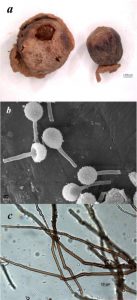Bovista helenae Rebriev, sp. nov., Index Fungorum number: IF 818785
Etymology: the species is named in honor of Elena V. Rebrieva.
Fruitbodies globose, depressed-globose or ovoid, 0.5 – 1.2 cm diam., subhypogeous. Exoperidium whitish, incrusted in sands and separated from endoperidium, loosing rapidly in maturity at upper part but saving in lower part as thick firm “cup”, without mycelial strands. Endoperidium dark-brown to blackish but discoloring to light-brown or whitish, thin, elastic; mouth roundish 1 – 3(4) mm diam. or sometimes slit-like, with recurving margins. Gleba olive- to dark-brown. Subgleba absent. Basidiospores globose to subglobose, brown, 3.2 –3.8 × 3.5 – 4.5 µm, asperulate in LM but with small warts in SEM; pedicels straight, not acute, 5–7 µm. Eucapillitium of Bovista-type, brown to dark-reddish-brown, branched (3 – 7 forks), elastic, up to 8–14 µm diam., without any septa; walls thin to medium, pores small, straight or funnel-shaped, rare on the main stem but usual on the ends.
Material examined: RUSSIA, Asrakhan region, Bogdinsko-Baskunchaksky state reserve, dry steppe with Poaceae and Artemisia, 21 October 2008, Y.A. Rebriev (LE 253875, holotype; isotype YuR 1914); same place, 21 Sept. 2014 (YuR 2986).
Fig. 1 Bovista helenae (LE 253875, holotype). a Basidiomes. b Spores. c Capillitium ends with abundant pores.

